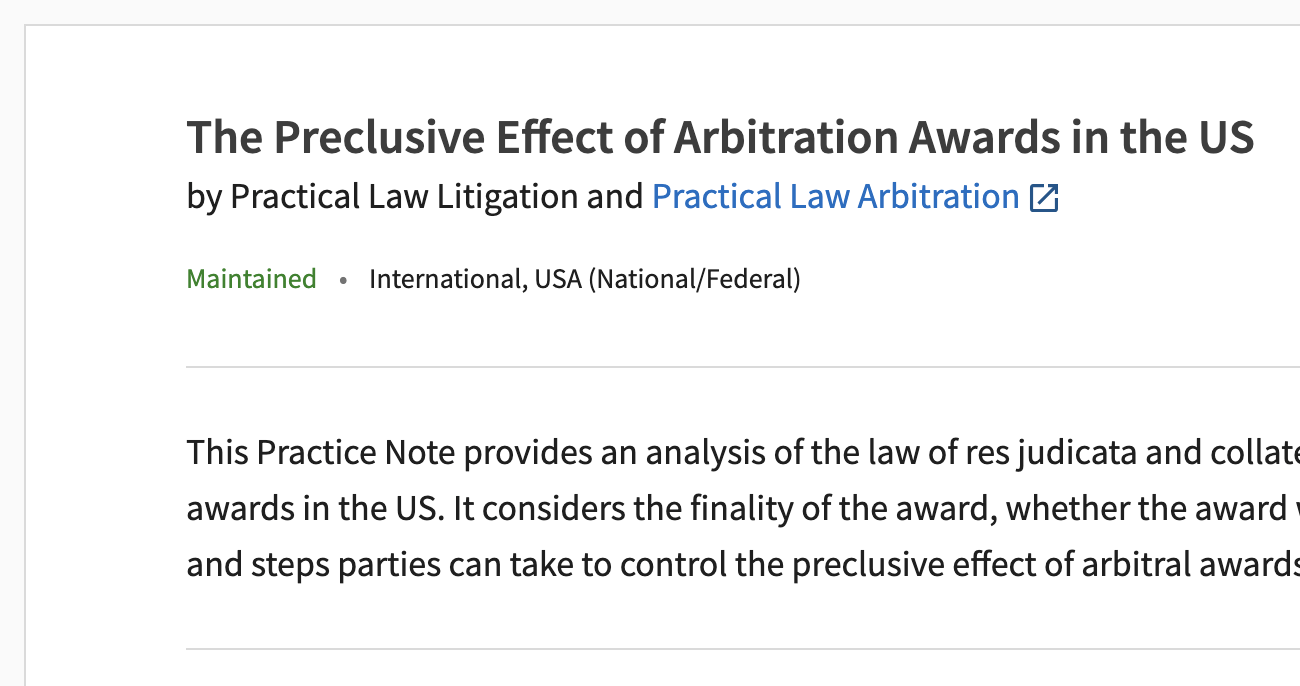Definition, examples, and related resources
In order to prevent needless waste of judicial time and energy, it is critical to ensure litigants do not overburden courts with redundant and duplicative proceedings. There are several legal doctrines aimed at that important preservation, most notably, “res judicata.”
Jump to ↓
Res judicata vs. collateral estoppel

Practical Law Practice Note
The Preclusive Effect of Arbitration Awards in the US
View practice note ↗What is res judicata?
Res judicata refers to the principle by which one judgment has a binding effect on subsequent proceedings. It encompasses two distinct effects:
- Claim Preclusion (True Res Judicata): This prevents the re-litigation of claims that were or could have been raised in a prior proceeding. Once a judgment is final, parties cannot pursue the same claim again, even if certain matters were not advanced earlier.
- Issue Preclusion (Collateral Estoppel): This precludes the re-litigation of specific issues that have already been conclusively determined in a previous judgment, even if the claims in the new case differ.
- Together, these principles ensure finality in legal disputes and prevent redundant litigation.
The doctrine, which derives from the Latin of “a matter judged”, is designed to prohibit parties from relitigating a claim or a defense of something that has already been adjudicated. The idea of res judicata emerged from the English common law and is meant to ensure the finality of judgments and conserve judicial resources. Additionally, the repeated litigation of an already adjudicated matter is generally not in the public’s best interest.
Under Title III, Rule 8(c)(1) of Federal Rules of Civil Procedure for the U.S. District Courts, “In responding to a pleading, a party must affirmatively state any avoidance or affirmative defense, including…res judicata”. This means that when a defendant is a party to a subsequent case, which has been adjudicated in a prior proceeding, the burden of proof is on the defendant to prove that res judicata is applicable.
The U.S. Court of Appeals noted in the case of Rivet v. Regions Bank of La. that res judicata is an affirmative defense. Additionally, if the defendant is successful in proving that res judicata is applicable, the entire case will be dismissed, irrespective of the facts and evidence raised by the plaintiff.
Conventional wisdom says that one judicial contest should be enough for litigants to make their claims or put forward a defense. This is critical as the amount of judicial work has increased significantly in recent years.
What are the three elements of res judicata?
Res judicata has three general elements: re-litigation, same cause of action, and same or closely related parties.
Re-litigation
Res judicata prevents a party from bringing a claim once that particular claim has been subjected to a final judgment on merits in some previous lawsuit. Re-litigation applies to a new lawsuit brought in any court, not just the one responsible for earlier judgment. This piece of res judicata is considered the most straightforward of the doctrine.
Same cause of action
Similarly, res judicata prevents a party from bringing the same claim or cause of action against the defendant once a final judgment has been made. The term ‘claim’ is the legal demand for compensation, while the cause of action is the set of elements that allow for legal remedy.
Same or closely related parties
If the parties to a lawsuit are individuals, it is inherently easier to identify if a new lawsuit does involve those individuals. However, the principle of res judicata can also prohibit litigation brought by parties or entities “in privity” to the party involved with the original lawsuit. This can include anyone “acting as an agent” on behalf of the original plaintiff, or any subsidiary of, for example, a corporate plaintiff. The same principle also applies to defendants.
Res judicata vs. collateral estoppel
The broader doctrine can be further divvied into two separate, major components: the first is res judicata, or “claim preclusion,” and the second is “collateral estoppel,” which is also known as issue preclusion.
Res judicata prohibits a second action on previously litigated matters as a whole and cause of actions/claims spawning from similar subject matter.
Alternatively, collateral estoppel prevents additional litigation of “particular issues” within previously resolved in prior cases. In practice, collateral estoppel is the principal concept behind double jeopardy protections for criminal defendants. As established in Benton v. Maryland, this protection is binding in both state and federal courts by the Due Process Clause of the Fourteenth Amendment.
To invoke the collateral estoppel, parties must establish several elements:
- First, the facts in question were fairly and fully litigated.
- The parties were deemed adversarial with respect to that action.
- The facts were essential to the first action’s judgment.
Examples
Res judicata has broad practical applications. Recently, its use was tested in the 2018 patent lawsuit, Sowinski v. California Air Resources Board, which affirmed res judicata applied not only to cases resolved on the merits —the facts and evidence of a case—but also ones adjudicated on procedural grounds.
The facts of the case are that in 2015 Richard Sowinski, inventor of an electronic method for claiming pollution tax credits, sued the California Air Resources Board (CARB) over their alleged use of his patent in one of their programs. The court dismissed the complaint because Sowinski failed to respond to motions before the deadline.
Sowinski filed a lawsuit again in 2018, this time seeking infringement damages from the 2015 case decision. He argued that res judicata should not apply since a prior suit was, in fact, resolved on procedural grounds, rather than the merits of the purported infringement. However, the U.S. Court of Appeals for the Federal Circuit affirmed the lower court ruling applying res judicata anyway, since the cases were essentially the same.

Practical Law Practice Note
TTAB Oppositions and Cancellations: Grounds and Defenses
View Practice Note ↗Exceptions
The doctrine of res judicata is not applicable in certain cases, or where certain essential elements are not present. Broadly, these exceptions can be clubbed in the following heads:
Dismissal of a claim for lack of jurisdiction or improper venue
For a judgment to be final and binding, it must be given by a court of competent jurisdiction. If the judgment is not final due to want of jurisdiction, then the doctrine of res judicata is not applicable.
The judgment or decision was not final
In the recent case of Scott v. Browne, the Court of Appeal of Louisiana noted that there are several essentials of the doctrine of res judicata. One of the main elements is that the judgment or order must be final. If it is a temporary order then a defendant cannot claim the defense of res judicata in subsequent proceedings.
Voluntary dismissal of a claim by the Plaintiff
A plaintiff may file a motion for voluntary dismissal of part of its cause of action and may file a fresh proceeding within one year of such voluntary dismissal or the period of limitation, whichever is greater. However, this has to be done with caution.
In the case of Hudson v. Chicago, the Illinois Supreme Court held that if a plaintiff splits a claim into multiple actions or suits, or files a motion of voluntary dismissal of part of the claim after adjudication of another part of the cause of action then the doctrine of res judicata will be applicable.
Dismissal due to defects or errors in the petition
In the case of Scott v. Browne, the court also noted that an exception to the rule of res judicata is when the prior proceeding is dismissed without prejudice, allowing the plaintiff to re-file the action after curing the defects, or where the judgment reserves the right of the plaintiff to bring another action.
Failure to join a relevant party under a mandatory joinder of parties rule
A key principle of res judicata is to prevent multiple suits on the same cause of action. This requires that every person who is necessary for the adjudication of a case should mandatorily be made a party to the suit.
However, this rule has developed in the last few years. The U.S. Court of Appeals in the case of Rodrigues v. Wells Fargo Bank noted that in the state of New Jersey, joinder of parties does not require dismissal of a subsequent action for a failure to join a party in a prior action unless the failure was inexcusable and the right of the non-joined party to defend has been substantially prejudiced.
What do attorneys need to know about res judicata in court
Generally, the value of res judicata lies in its preservation of time and resources. It is also, logically, a very intuitive piece of law. The burdens to the court are obvious when you remove important protections against waste and frivolity.
“If at first you don’t succeed, try again” is a fine concept for little leaguers and struggling artists; however, it doesn’t work quite so well for attorneys, judges, plaintiffs, and defendants. For these reasons, we see great application of the doctrine of res judicata in our judicial system.
For more information about how to apply and counteract relevant, emerging legal doctrines like res judicata, see our coverage of the increasingly applied “Reptile Theory.”
Related research resources
The Latin quote “Interest rei publicae ut sit finis litium” which means “It is in the interest of the state that there be an end to litigation” properly summarizes the effect of res judicata.
Res Judicata is an important doctrine of common law and is often invoked by courts to prevent relitigation and provide finality to a decision. It helps in conserving judicial resources, however, before taking a defense of res judicata, ensure that all the essentials of the doctrine are fulfilled and your case does not fall into any of the exceptions.
Originally published November 11, 2022







